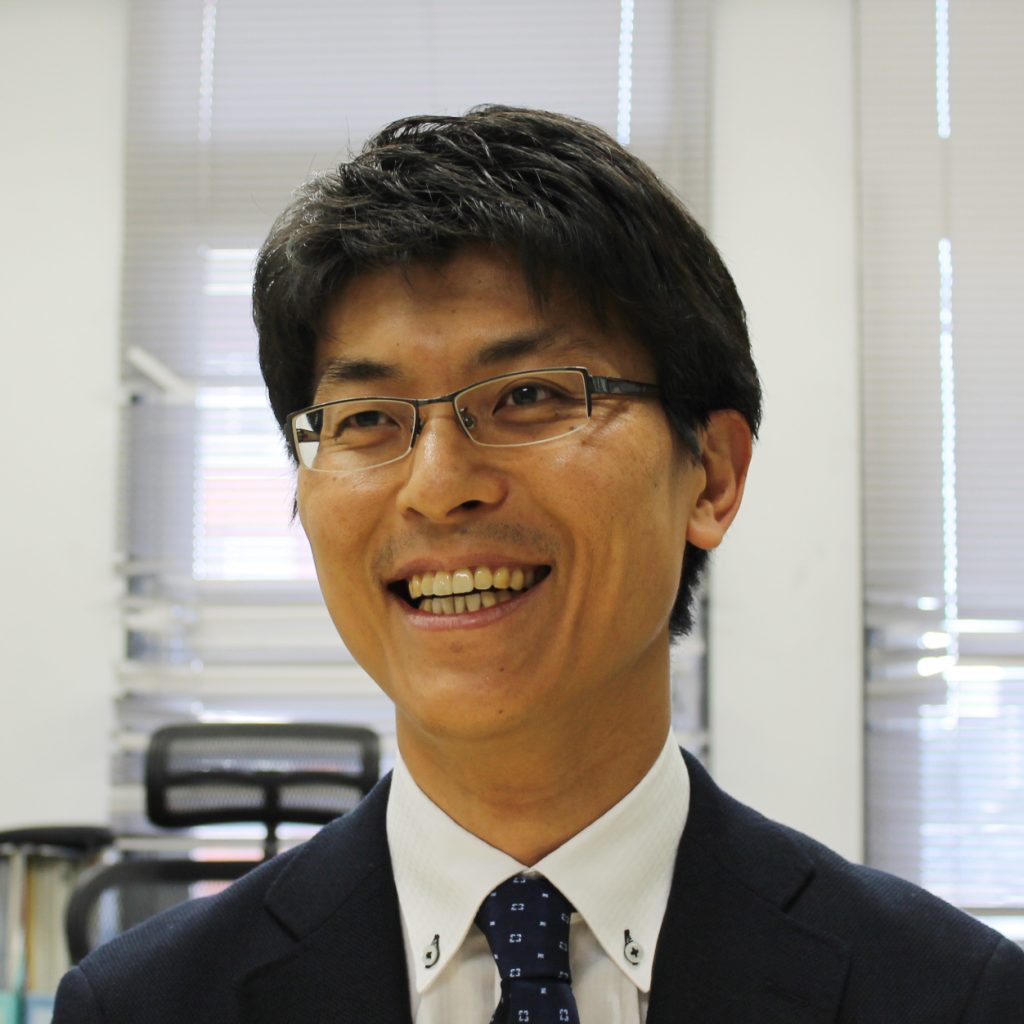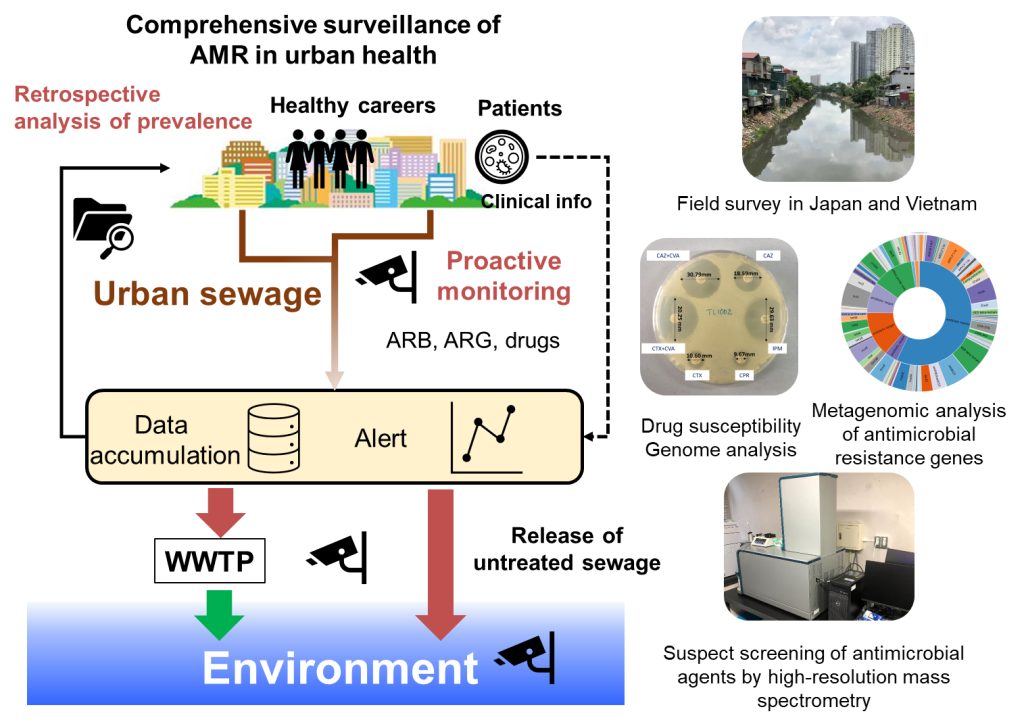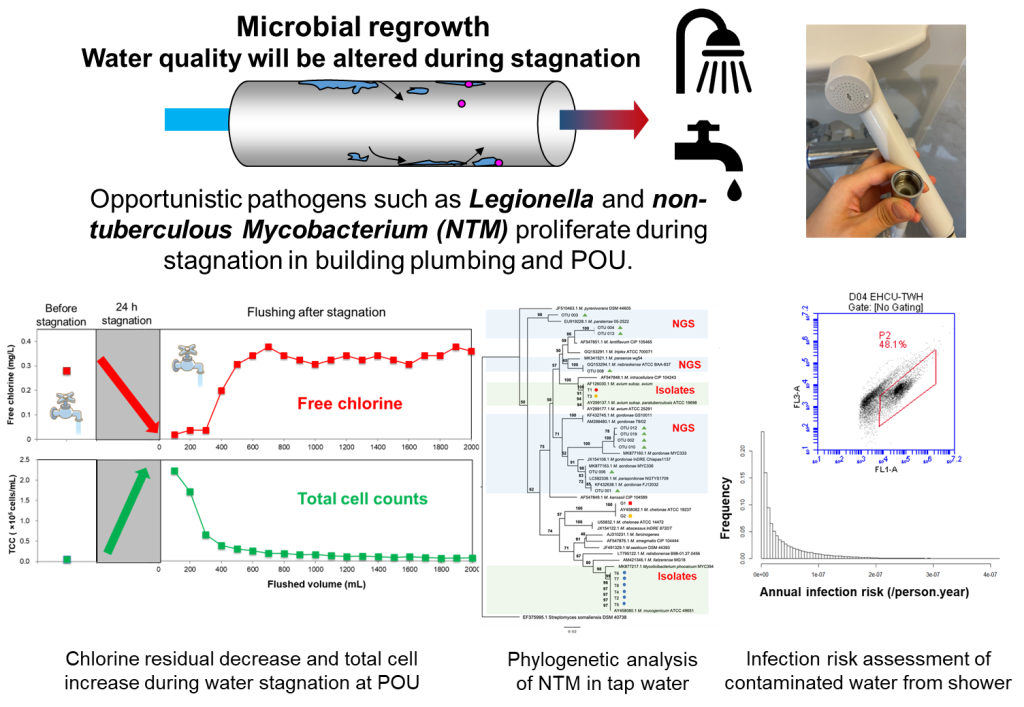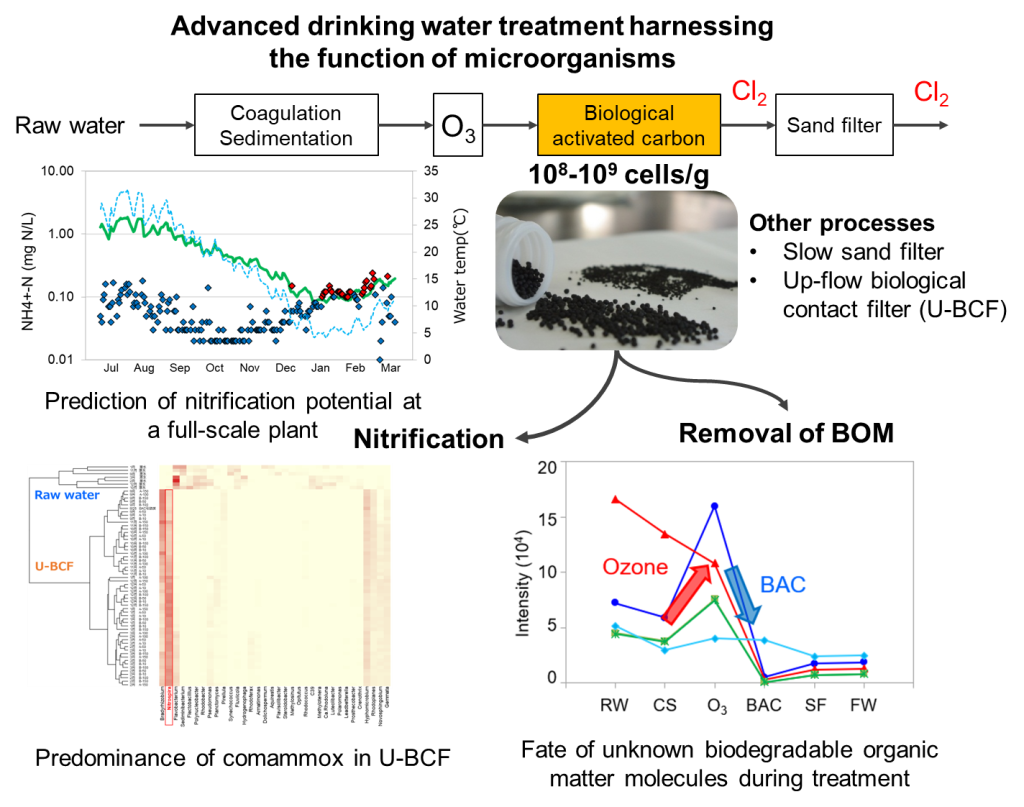
Ikuro Kasuga, Ph.D, Associate Professor
Research Center for Advanced Science and Technology
Dept. of Urban Engineering, Graduate School of Engineering
Project Assoc Prof., International Wastewater-based Epidemiology Program, RECWET
Collaborative Research Institute for Innovative Microbiology
International Institute for Next Urban Planning, Design and Management
Visiting Assoc Prof., Nagasaki University
Biography
Education
- 2002 - 2005 : The University of Tokyo, PhD Program, Department of Urban Engineering, PhD in Engineering (March 2005)
- 2000 - 2002 : The University of Tokyo, MSc Program, Department of Urban Engineering
- 1996 - 2000 : The University of Tokyo, Undergraduate Program, Department of Urban Engineering
Employment
- 2022-present: Associate Professor, Reserach Center for Advance Science and Technology, The University of Tokyo
- 2016 Sep-2021 Mar: JICA long-term expert, Vietnam Japan University, Hanoi, Vietnam
- 2016-2022 : Associate Professor, Dept. of Urban Engineering, The University of Tokyo
- 2013-2016 : Senior Assistant Professor, Dept. of Urban Engineering, The University of Tokyo
- 2006-2013 : Assistant Professor, Dept. of Urban Engineering, The University of Tokyo
- 2005-2006 : Post-doc researcher, Dept. of Water Supply, National Institute of Public Health, Japan
Research topics
- Comprehensive surveillance and control of antimicrobial resistance in urban water system
- Control of microbial regrowth in water supply system
- Characterization of microbial functions in biological drinking water treatment
1. Comprehensive surveillance of and control of AMR in urban water system
The spread of antimicrobial resistance (AMR), in which antimicrobial agents are ineffective, is becoming more apparent. Antimicrobial resistant bacteria (ARB) can acquire antimicrobial resistance genes (ARG) through horizontal gene transfer. If no action is taken, it is estimated that by 2050, 10 million deaths will occur annually worldwide, making it the leading cause of death. The problem of AMR requires a One Health approach that integrates the health of humans, animals, and the environment. Systematic surveillance has been conducted for humans and livestock animals, while little information is available for AME in the environment. There is a need to establish a frame for comprehensive monitoring of AMR risk in the environment.
Wastewater treatment plants in urban water system are located at the interface between the urban city and the environment. Wastewater-based epidemiology is effective for proactive monitoring. Moreover, it is required to update treatment performance for mitigating dissemination of ARB/ARG to the environment. On the other hand, in developing countries with low sewage treatment rates, there is concern that ARB are spreading into the environment along with the release of untreated sewage. They can return to society through water and food contamination. Increasing the sewage treatment rate, which SDGs 6.3.1 aims for, does not only improve water quality, but also contribute to the control of AMR.

<Major topics>
- Comprehensive surveillance of AMR risk factors in water environment
- Wastewater-based epidemiology to characterize AMR pollution (antimicrobial resistant bacteria, antimicrobial resistance genes, drugs) in urban wastewater in Japan and Vietnam
- Optimization of treatment efficiency of wastewater treatment for mitigating AMR risk
<Major achievements>
- Kasuga, I., Nagasawa, K., Suzuki, M., Kurisu, F., and Furumai, H. High-throughput screening of antimicrobial resistance genes and their associations with class 1 integrons in urban rivers in Japan. Frontiers in Environmental Science-Toxicology, Pollution and the Environment, 10, 825372, 2022. https://doi.org/10.3389/fenvs.2022.825372
- Hirabayashi, A., Dao, T.D., Takemura, T., Hasebe, F., Trang, L.T., Thanh, N.H., Tran, H.H., Shibayama, S., Kasuga, I., and Suzuki, M. A transferable IncC-IncX3 hybrid plasmid co-carrying blaNDM-4, tet(X4), and tmexCD3-toprJ3 confers resistance to carbapenem and tigecycline. mSphere, 6(4), e00592-21, 2021. https://doi.org/10.1128/mSphere.00592-21
- Nguyen, T.N., Liu, M., Katayama, H., Takemura, T., and Kasuga, I. Association of the colistin resistance gene mcr-1 with fecal pollution in water environments in Hanoi, Vietnam. Letters in Applied Microbiology, 72 (3), 275-282, 2021.https://doi.org/10.1111/lam.13421
<Related information>
- WHO: Antimicrobial resistance
- UNEP: AMR, a global threat
- CDC: Combating AMR, a global threat
- One Health Trust: Resistance Map
- Martin J. Blaser:Missing Microbes -How the overuse of antibiotics is fueling our modern plagues- (Henry Holt and Co., 2014)
- Alanna Colen: 10% Human -How your body’s microbes hold the key to health and happiness- (Harper Paperbacks, 2016)
2. Control of microbial regrowth in water supply system
Tap water disinfected at a drinking water treatment plant and maintained with residual chlorine is biologically stable. However, it is possible that residual chlorine in tap water will be lost due to stagnation of tap water in building plumbing or at the point-of-use devices. As a result, some microorganisms that are left viable in the water can regrow. These microorganisms may include opportunistic pathogenic bacteria such as Legionella and non-tuberculous Mycobacterium (NTM).
So far, enteric infection caused by drinking tap water has been considered in microbial risk assessment. However, Legionella and NTM can cause respiratory infections through intake of aerosols. Tap water is used not only for drinking, but also for showering and washing which can generate aerosols contaminated with those microbes. In aging society where the number of people decreases, the frequency of water stagnation increases as water demand decreases. The increase in immunocompromised elderly people in hospitals and health-care facilities also increases the risk of waterborne opportunistic infections caused by microbial regrowth. Under the current Water Supply Law in Japan, only E. coli and heterotrophic plate counts are monitored. Little information is available for the occurence of Legionella and NTM in premise/building plumbing and POU. It is necessary to reveal the actual situation of microbial regrowth risk in tap water, and to upgrade water quality management to control microbial regrowth.

<Major topics>
- Microbial community structures in showerhead biofilm
- Quantitative microbial risk assessment of waterborne infection risk considering regrowth of non-tuberculous Mycobacterium
- Molecular-level characterization of unknown biodegradable organic matter supporting microbial regrowth
<Major achievements>
- Gan, Y., Rahmatika, I., Kurisu, F., Furumai, H., Simazaki, D., Fukano, H., Hoshino, Y. and Kasuga, I. The fate and risk of nontuberculous mycobacteria in water supply system: A review. H2Open Journal, 5(2), 180-197, 2022. https://doi.org/10.2166/h2oj.2022.144
- Rahmatika, I., Kasuga, I., Kurisu, F., and Furumai, H. Dynamics of microbial community and opportunistic pathogens after water stagnation in premise plumbing of a building. Microbes and Environments, 37(1), ME21065, 2022. https://doi.org/10.1264/jsme2.ME21065
- Kasuga, I., Suzuki, M., Kurisu, F., and Furumai, H. Molecular-level characterization of biodegradable organic matter causing microbial regrowth in drinking water by non-target screening using Orbitrap mass spectrometry. Water Research, 184, 116130, 2020. https://doi.org/10.1016/j.watres.2020.116130
- Rahmatika, I., Kasuga, I., Kurisu, F., and Furumai, H. Impacts of organic matter migrating from pipe materials on microbial regrowth in drinking water. Journal of Water and Environment Technology, 18(1), 45-53, 2020. https://doi.org/10.2965/jwet.19-078
<Related information>
- “Microbial Growth in Drinking-Water Supplies: Problems, Causes, Control and Research Needs” : Dirk ven der Kooij and Paul van der Wielen, IWA Publishing, 2013.
- CDC: Water Management Program
- CDC: Spread of Legionella via water use
- Estimate of Burden and Direct Healthcare Cost of Infectious Waterborne Disease in the United States
3. Characterization of microbial functions in biological drinking water treatment
In urban areas, ozone and biological activated carbon (BAC) treatment is widely used as an advanced water purification process. In BAC treatment, hybrid mechanism of physico-chemical adsorption and biological oxidation of microorganisms associated with granular activated carbon are expected. However, biological treatment has been viewed as a black box and operated on an empirical basis. By clarifying the diversity and functions of microorganisms contributing to biological treatment, it is expected that the potential and limitations of biological functions can be revelaed which is informative to optimize design parameters and operating conditions.
The major biological functions include the oxidation of biodegradable organic matter and ammonia. Removal of biodegradable organic matter is important to control microbial regrowth in water supply system. Ammonia can react with chlorine to form trichloramine under certain conditions, which can cause chlorinous odor. The biological oxidation of ammonia (nitrification) in water treatment is not only carried out by traditional ammonia-oxidizing bacteria (AOB), but also by novel microorganisms such as ammonia-oxidizing bacteria (AOA, 2005) and complete ammonia-oxidizing bacteria (Comammox, 2015). As the novel microorganisms are more dominant than AOB in most of biological drinking water treatment, their functions should be expplored for optimizing the performance of water engineering.

<Major topics>
- Characterization of predominant complete ammonia oxidizers (Comammox) in biological drinking water treatment
- Production of biologically stable drinking water utilizing bacteria which are involved in the removal of assimilable organic carbon
<Major achievements>
- Kasuga, I., Nakamura, H., Kurisu, F., and Furumai, H. Characterization of microbial regrowth potential shaped by advanced drinking water treatment. H2Open Journal, 4(1), 157-166, 2021. https://doi.org/10.2166/h2oj.2021.103
- Jantarakasem, C., Kasuga, I., Kurisu, F., and Furumai, H. Temperature-dependent ammonium removal capacity of biological activated carbon used in a full-scale drinking water treatment plant. Environmental & Science Technology, 54(20), 13257-13263, 2020. https://doi.org/10.1021/acs.est.0c02502
- Kasuga, I., Suzuki, M., Kurisu, F., and Furumai, H. Molecular-level characterization of biodegradable organic matter causing microbial regrowth in drinking water by non-target screening using Orbitrap mass spectrometry. Water Research, 184, 116130, 2020. https://doi.org/10.1016/j.watres.2020.116130
- Kasuga, I., Nakagaki, H., Kurisu, F., and Furumai, H. Predominance of ammonia-oxidizing Archaea on granular activated carbon used in a full-scale advanced drinking water treatment plant. Water Research, 44(17), 5039-5049, 2010. https://doi.org/10.1016/j.watres.2010.07.015
<Related information>
- Nature: A division of labour combined
Peer-reviewed papers
Invited lecture・Keynote speech
- Kasuga, I. (2021) Surveillance of antimicrobial resistance in water environment and wastewater in Vietnam, Resistomap Webinar Series -Monitoring ARGs in LMICs-. (29 June, online) [Invited lecture]
- Kasuga, I. (2020) Evaluation of antimicrobial resistance in water-food nexus in Vietnam, VNU Vietnam -Japan University Scientific Conference. (21 December, Hanoi) [Invited lecture]
- Kasuga, I. (2020) Dissemination of antimicrobial resistance in water environment in Vietnam, IFGTM 2020 (10th International Forum for Green Technology and Management). (28 November, Hanoi) [Keynote speech]
- Kasuga, I. (2020) The screening of antibiotic resistance genes in water environments in Vietnam and Japan, Resistomap Webinar Series -Introduction to the environmental dimension of antibiotic resistance-. (25 August, online) [Invited lecture]
- Kasuga, I. (2020) Tackling Antimicrobial Resistance in the Context of SDGs in Asia, 5th International Symposium on Sustainable Future in Asia/5th NIES International Forum, (21-22 January, Yangon, Myanmar) [Invited lecture]
- Kasuga, I. (2019) Potential health risk of antimicrobial resistance in water environment in Hanoi, Vietnam, 1st Symposium of JSPS Core-to-Core Program: “Center of Excellence in Health Risk Assessment for Adaptation to Climate Change” (11-12 November, Manila, Philippines) [Invited lecture]
- Kasuga, I. (2019) Drinking Water Quality Management After Treatment -Risks of Microbial Regrowth in Distribution System and Premise Plumbing-, The 9th International Forum Green Technology and Management (IFGTM) (27-28 September, Hanoi, Vietnam). [Invited lecture]
- Kasuga, I. (2019) Control of microbial regrowth in premise plumbing -Challenge of aging water supply systems-, Vietnam-Japan Science and Technology Towards Sustainable Development 2019, E-6-K-085. (4 May, Hanoi) [Keynote speech]
- Kasuga, I. (2019) Safely managed water services beyond SDG 6.1, 4th International Forum on Sustainable Future in Asia, p.46 (23-24 January, Hanoi, Vietnam) [Invited lecture]
- Kasuga, I. (2018) Evaluation of biodegradable organic matter causing regrowth in drinking water, The 3rd International Forum on Asian Water Environment Technology, p.27. (2018.3.2, National University of Singapore, Singapore) [Invited lecture]
- Kasuga, I. (2015) Unveiling Functional Microorganisms Associated with Biological Activated Carbon for Advanced Water Purification, Advanced Water Management Workshop, the 2015 International Environmental Engineering Conference (IEEC2015), AWM-03. (29 October), [Busan, Korea] [Keynote speech]
- Kasuga, I. (2013) Identification of bacteria involved in the removal of AOC in BAC filtration. UT-PUB Joint Meeting. (24 January, PUB, Singapore) [Invited lecture]
- Kasuga, I. (2012) Functional characterization of microbial community in biological activated carbon process for water purification, INSA Lyon-JSPS Workshop “Water and Urban Environment”, pp.22-23. (19-20 June, Lyon, France) [Invited lecture]
- Kasuga, I. (2009) Characterization of ammonia-oxidizing archaea associated with biological activated carbon used for advanced drinking water treatment, International Workshop on water and Wastewater Treatment. (23-25 October, National Cheng Kung University, Tainan, Taipei) [Invited lecture]
Awards
- JSWE Paper Award, Awarded paper, Related paper1, Related paper 2(2022)
- Best Researcher Award, Graduate School of Engineering, The University of Tokyo (2022)
- JSWE WET Excellent Paper Award, Co-authored paper(2020)
- JSWE METAWATER Excellent Paper Award, Co-authored paper(2019)
- Best Teaching Award, Graduate School of Engineering, The University of Tokyo (2016)
- JSWE WET Excellent Paper Award, Co-authored paper(2016)
- JWWA Paper Award, Awarded paper(2015)
- JSWE Paper Award for Young Researchers, Awarded paper(2011)
- JSWE METAWATER Excellent Paper Award, Co-authored paper(2009)
Lecture
- 3716-045 Advanced Water Quality Engineering
- 3716-094 Fundamental Water Pollution Control
